Feb 2012
Weaned pup loses struggle for survival
Feb/26/12 05:39 AM
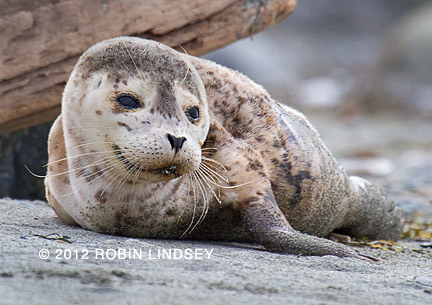
Sadly, the pup died overnight at PAWS. The male pup weighed a woeful 11.3 kg; healthy body weight for a pup in the wild at 6 or 7 months old should be upwards of 28-30 kg. It is suspected that he suffered from a parasite load (most likely lungworm), a common and serious health issue faced by weaned pups.
This pup’s death only reinforces the urgent need for all seal pups to be able to get the rest they require for survival. A pup who looks relatively plump one day, can be on death’s door only a few days later as parasites and viruses fight for control. As we have reminded folks time and again, a pup only has a 50% chance of survival the first year. On our West Seattle beaches, with informed and protective citizens, we offer these vulnerable pups a better chance by giving them a safe and quiet space. We can honor this beautiful pup by continuing to do so. You can help - please plan to attend our March 3rd training.
PUPDATE: We continue to have pups using the beaches and offshore platforms in West Seattle. Yesterday, a pup (or two - photos are being examined for id purposes) came ashore twice at Lincoln Park. This continues to be a dangerous location for pups due to issues with off leash dogs. Heads up and call the hotline @ 206-905-7325 (SEAL) if you spot a pup!
Platforms provide safe offshore haven for wildlife
Feb/26/12 04:46 AM

If you’re interested in constructing a raft off your waterfront property, please contact us and we can provide the plans to build one. Not only will you be providing safety for our flippered (and feathered) friends, you and your neighbors will enjoy many fascinating hours watching wildlife! During harbor seal pupping season, we have even seen a mom nurse her pup over the course of several weeks.
SIX pups on the beach yesterday - you can help
Feb/24/12 07:44 AM
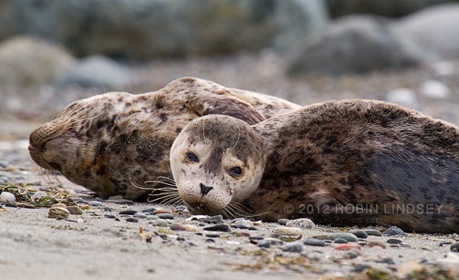
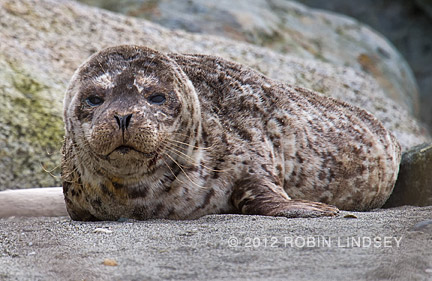
Lots of little blubberballs still hanging around
Feb/21/12 07:44 PM
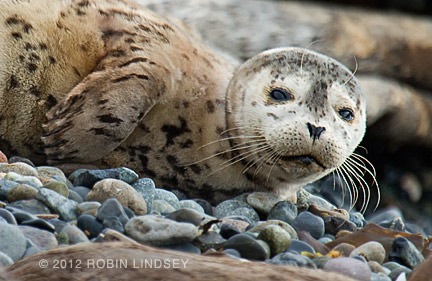
This afternoon, we had a gorgeous golden pup resting soundly at Lincoln Park while volunteers braved what felt like sustained hurricane force winds whipping up and off the whitecaps. To say it was brisk duty is an understatement. This pup has been identified as the same one who has used a stretch of private beach along Alki the past two days. The homeowner who originally reported the pup has nicknamed him/her Chris - in honor of a dear neighbor who sadly passed away that same day.
It will be interesting to see where Chris shows up tomorrow, so be on the alert. While observing Chris this afternoon, a beach walker mentioned that a second pup had been on the beach in a different location, but it was not reported to Seal Sitters. Please call our hotline @ 206-905-7325 (SEAL) whenever you spot a vulnerable pup on shore - they need to be able to rest undisturbed.
Sandy the satellite-tagged pup near Vashon Island
Feb/21/12 06:47 AM
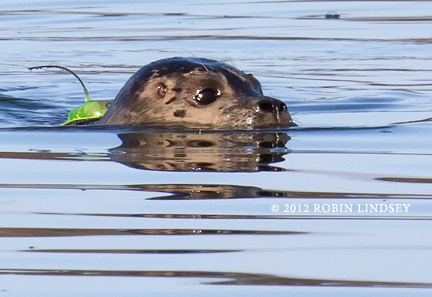
Keep your eyes peeled for a little seal pup with a yellow transmitter on her back. If you see her, please keep your distance and call our hotline @ 206-905-7325 (SEAL). Her movements are being studied by biologists and will give tremendous insight into the behavior of rehabilitated pups as they try to adapt to life back in the wild. SeaDoc has a web page devoted to Sandy here and you can receive email updates as to her locations and cheer her on. It is very exciting for volunteers and the public to be able to follow Sandy’s progress and see how well she is doing back in the Salish Sea.
New volunteer training set for March 3rd
Feb/18/12 05:41 PM
Seal Sitters will hold a training for new volunteers on Saturday, March 3, 2012 from 10am-12:30ish. The event will be held at beautiful Camp Long in West Seattle, 5200 35th Ave SW (just south of Dawson- map it). This session will be a special training for those wanting to respond to and protect marine mammals on the beaches of West Seattle and along the Duwamish River. A multi-media presentation by SS lead investigator Robin Lindsey will illustrate our educational work in the community and the particular challenges of protecting seals and seal pups in an urban environment. Zoologist and SS education and science advisor Buzz Shaw will discuss the biology and behavior of seals and other pinnipeds of Puget Sound. A followup on-the-beach training will be scheduled in the weeks to come. There will be no training sessions during the summer or height of pupping season due to time and staff constraints; however, there will be a new volunteer training in late May if you can’t make this date. Contact us if you have any questions.
Space permitting, we encourage current volunteers to feel free to come in for a “tune up” - and we could always use a helping hand with setup and breakdown. Please rsvp as seating is limited to 60.
For more information about volunteering, please visit our website.
Space permitting, we encourage current volunteers to feel free to come in for a “tune up” - and we could always use a helping hand with setup and breakdown. Please rsvp as seating is limited to 60.
For more information about volunteering, please visit our website.
Satellite Sandy spreads her wings in the Salish Sea
Feb/16/12 09:47 PM
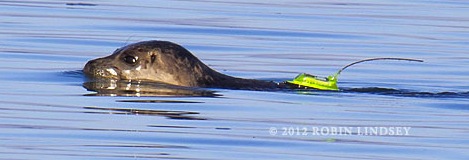
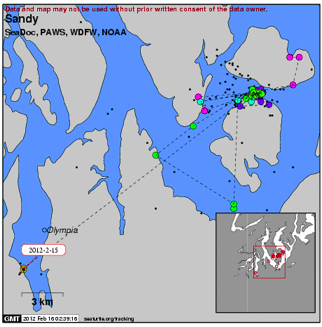
You can follow Sandy’s travels on SeaDoc’s website. In fact, you can even get an email alert when passing satellites pick up her signal. Check out Sandy’s dedicated page here. And, if you happen across a log boom, grab your binocs and see if there is a seal or two catching some zzzz’s - maybe you’ll even see Sandy with her fancy yellow hat!
Stranding network examines dead Southern Resident orca
Feb/13/12 09:24 PM
A team of biologists and volunteers from NOAA’s NW Marine Mammal Stranding Network, including Seal Sitters, conducted a necropsy on a juvenile orca from the Southern Resident “L” pod on the Long Beach Peninsula yesterday. While the majority of network responses are to seal pups and other pinnipeds, every year whales of all species strand along the shores of Washington State. This is the second killer whale stranding in the past three months.
The full report prepared by Jessie Huggins (Cascadia Research - photo left), Deb Duffield (Portland State University) and Dyanna Lambourn (Washington Department of Fish and Wildlife - photo right) follows:
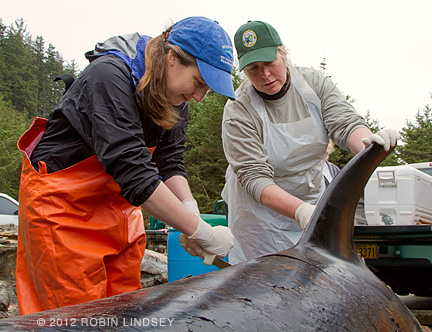 A detailed external and internal examination was conducted on February 12, 2012 of a stranded killer whale that washed up just north of Long Beach, Washington on the morning of February 11. The 12’3” (3.75m) juvenile female was taken to a secure location for a full necropsy by biologists and volunteers from a number of organizations that are part of the Northwest Marine Mammal Stranding Network, including Portland State University, Cascadia Research, Washington Department of Fish and Wildlife Marine Mammal Investigations, Seaside Aquarium, Seattle Seal Sitters, the Makah Tribe, and NOAA Fisheries.
A detailed external and internal examination was conducted on February 12, 2012 of a stranded killer whale that washed up just north of Long Beach, Washington on the morning of February 11. The 12’3” (3.75m) juvenile female was taken to a secure location for a full necropsy by biologists and volunteers from a number of organizations that are part of the Northwest Marine Mammal Stranding Network, including Portland State University, Cascadia Research, Washington Department of Fish and Wildlife Marine Mammal Investigations, Seaside Aquarium, Seattle Seal Sitters, the Makah Tribe, and NOAA Fisheries.
Photographs of the dorsal fin and saddle patch were matched to catalogs of known killer whales by biologists from National Marine Fisheries Service and the Center for Whale Research. She has been identified as L112, a member of the Southern Resident L Pod. Born in 2009, she was the second surviving calf of L86.
The whale was moderately decomposed and in good overall body condition. Internal exam revealed significant trauma around the head, chest and right side; at this point the cause of these injuries is unknown. There have been reports of sonar activity in the Strait of Juan de Fuca in the past week and a half and members of K and L pod were reportedly in the area at the time as well. We do not know if this whale was among those in the area but the possibility is under consideration. The skeleton will be cleaned and closely evaluated by Portland State University for signs of fracture and the head has been retained intact for biological scanning. Additionally, samples were taken for a variety of analyses: genetics, contaminants, bacteriology, virology, food habits, biotoxins and histopathology. The processing of these tissue samples could take several weeks or months and will hopefully provide insight into the origin of the traumatic injuries or other factors that may have contributed to the death of this whale.
This is the second killer whale to strand on the Long Beach peninsula in the past three months. The first case was a killer whale calf that stranded north of the Seaview Beach approach on November 14, 2011. The carcass was promptly collected and transported to Portland State University, where thorough necropsy was conducted by Portland State University, Washington Department of Fish and Wildlife Marine Mammal Investigations, Cascadia Research, NOAA, and Dr. Stephen Raverty. A genetics sample was taken and the female calf has been confirmed as an eastern North Pacific offshore. A congenital defect was determined to be the cause of death in this case.
More information on killer whales can be found on the Cascadia Research killer whale page, at the Center for Whale Research, Fisheries and Oceans Canada, and the Northwest Fisheries Science Center websites.
View a condensed photo gallery of the necropsy here. Warning: necropsies are graphic events and while every effort has been made to be discreet in photo selection, some may be disturbing and are not recommended for children.
The full report prepared by Jessie Huggins (Cascadia Research - photo left), Deb Duffield (Portland State University) and Dyanna Lambourn (Washington Department of Fish and Wildlife - photo right) follows:

Photographs of the dorsal fin and saddle patch were matched to catalogs of known killer whales by biologists from National Marine Fisheries Service and the Center for Whale Research. She has been identified as L112, a member of the Southern Resident L Pod. Born in 2009, she was the second surviving calf of L86.
The whale was moderately decomposed and in good overall body condition. Internal exam revealed significant trauma around the head, chest and right side; at this point the cause of these injuries is unknown. There have been reports of sonar activity in the Strait of Juan de Fuca in the past week and a half and members of K and L pod were reportedly in the area at the time as well. We do not know if this whale was among those in the area but the possibility is under consideration. The skeleton will be cleaned and closely evaluated by Portland State University for signs of fracture and the head has been retained intact for biological scanning. Additionally, samples were taken for a variety of analyses: genetics, contaminants, bacteriology, virology, food habits, biotoxins and histopathology. The processing of these tissue samples could take several weeks or months and will hopefully provide insight into the origin of the traumatic injuries or other factors that may have contributed to the death of this whale.
This is the second killer whale to strand on the Long Beach peninsula in the past three months. The first case was a killer whale calf that stranded north of the Seaview Beach approach on November 14, 2011. The carcass was promptly collected and transported to Portland State University, where thorough necropsy was conducted by Portland State University, Washington Department of Fish and Wildlife Marine Mammal Investigations, Cascadia Research, NOAA, and Dr. Stephen Raverty. A genetics sample was taken and the female calf has been confirmed as an eastern North Pacific offshore. A congenital defect was determined to be the cause of death in this case.
More information on killer whales can be found on the Cascadia Research killer whale page, at the Center for Whale Research, Fisheries and Oceans Canada, and the Northwest Fisheries Science Center websites.
View a condensed photo gallery of the necropsy here. Warning: necropsies are graphic events and while every effort has been made to be discreet in photo selection, some may be disturbing and are not recommended for children.
Seal pup Flipper flops ashore on Alki Beach
Feb/06/12 05:37 AM

Nicknamed Flipper by (almost) 9 year old Natasha who was walking along the beach with her dad, the pup slept and warmed up until almost dark. He returned to the Sound in search of dinner and our volunteers, windswept and shivering by this time, removed the perimeter and left satisfied, knowing that the pup got the rest he needed and that they had educated many people to the wondrous ways of seals and seal pups. The orcas also made an appearance yesterday in West Seattle and volunteers nervously wondered if it was a transient or resident pod. The transients feed on seals and sea lions, but the residents are fish eaters. So, we were all happy that Flipper chose to stay on the steps til the orcas were long gone!
Investigation widens as more shot sea lions found in Puget Sound
Feb/02/12 05:40 PM
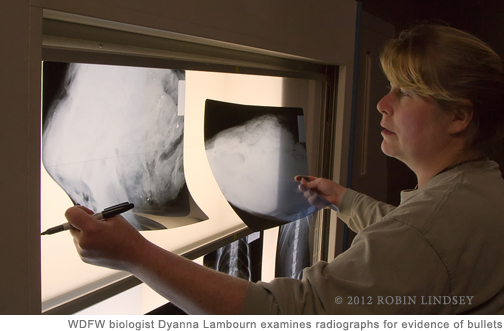
in Puget Sound, there have been 4 California sea lions and 1 adult harbor seal; in Hood Canal, 1 threatened Steller sea lion; on the outer coast of Washington, 1 California sea lion; most recent, in the Nisqually Refuge, 1 California sea lion.
Unsubstantiated reports this week by some media of a “shot baby sea lion” were untrue. Instead, a dead harbor seal pup was reported at Picnic Point in Edmonds. The reporting party said the animal was shot and gave an incorrect identity of species. There was no evidence of foul play when photos of the pup were reviewed by marine mammal stranding experts. Most likely, the person who found the animal mistakenly thought the pup’s tiny ear hole was a bullet entry wound. This is a common misconception by the public since harbor seals have no external ear flap.
Determining the cause of death for a marine mammal can challenge even the most experienced of biologists. Small entry wounds are extremely difficult to see on a massive, often decomposed animal. According to WDFW marine mammal biologist Dyanna Lambourn, more often than not, trauma from a bullet (such as hemorrhaging and tissue damage) is usually discovered once the animal is opened up for necropsy. Once the damage is discovered, the investigators are able to track back through the body to find the entry wound. Often, there is suspicion of a bullet wound, but the bullet itself is not found on initial exam. Radiographs reveal clear evidence of fragmented bone and often the embedded bullet itself. Dyanna is shown here (photo above) reviewing radiographs of recent sea lion shootings. These new radiographs proved that the Lincoln Park sea lion had been shot in the head as well as left lung.
It is imperative that the public continue to call with reports of all dead seals and sea lions: call NOAA’s hotline at 1-800-853-1964 or Seal Sitters’ Hotline at 206-905-7325 (SEAL) for all West Seattle reports. Scavenger damage and natural decomposition can cause small external wounds and holes in the carcasses of dead marine mammals. Please do not assume the animal you are reporting has been shot. When at all possible, trained professionals will respond if the condition of the animal is fresh and the best available data can be collected. Photos from the public are helpful in determining species and general condition in case the animal cannot be located or if response is not possible. When reporting, please provide hotline operators with as precise a location of the animal as possible, including notable landmarks. Necropsies are performed to keep tabs on the health of the populations and monitor signs for outbreak of disease or other factors contributing to death - and, of course, provide evidence if indeed there is foul play.
There is an on-going investigation by NOAA’s Office for Law Enforcement regarding the shooting deaths of these animals. Please call 1-800-853-1964 to report any suspicious activity regarding marine mammal harassment or if you have any information regarding these shootings. Sea Shepherd Society has offered a $10,000 reward for information leading to arrest and conviction in this case.
Ribbon seal still in Northwest waters
Feb/01/12 03:23 PM
The adult male weighed in at 166.5 lbs and measured 55 inches in length. These values are well within the average range of its age class. A small skin sample was collected for genetics analysis and the blood samples collected will be analyzed. This information is very valuable and will allow us to assess the overall health of the animal.
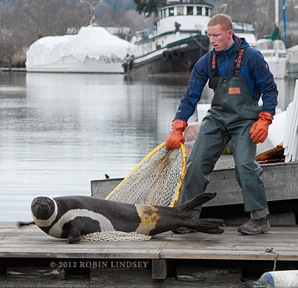
We encourage the public to continue to report sightings of this animal to NOAA’s Marine Mammal Stranding Specialist, Kristin Wilkinson at 206-526-4747. View an online still image gallery of the ribbon seal and the health examination by researchers.







